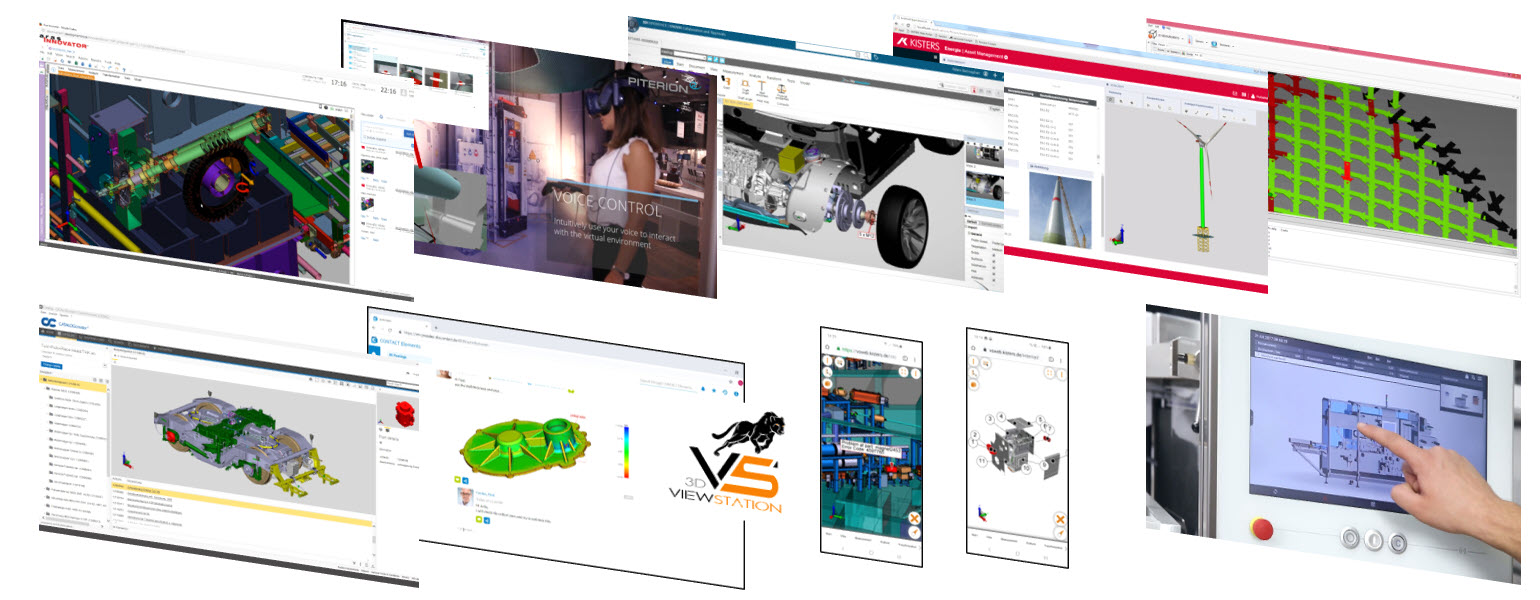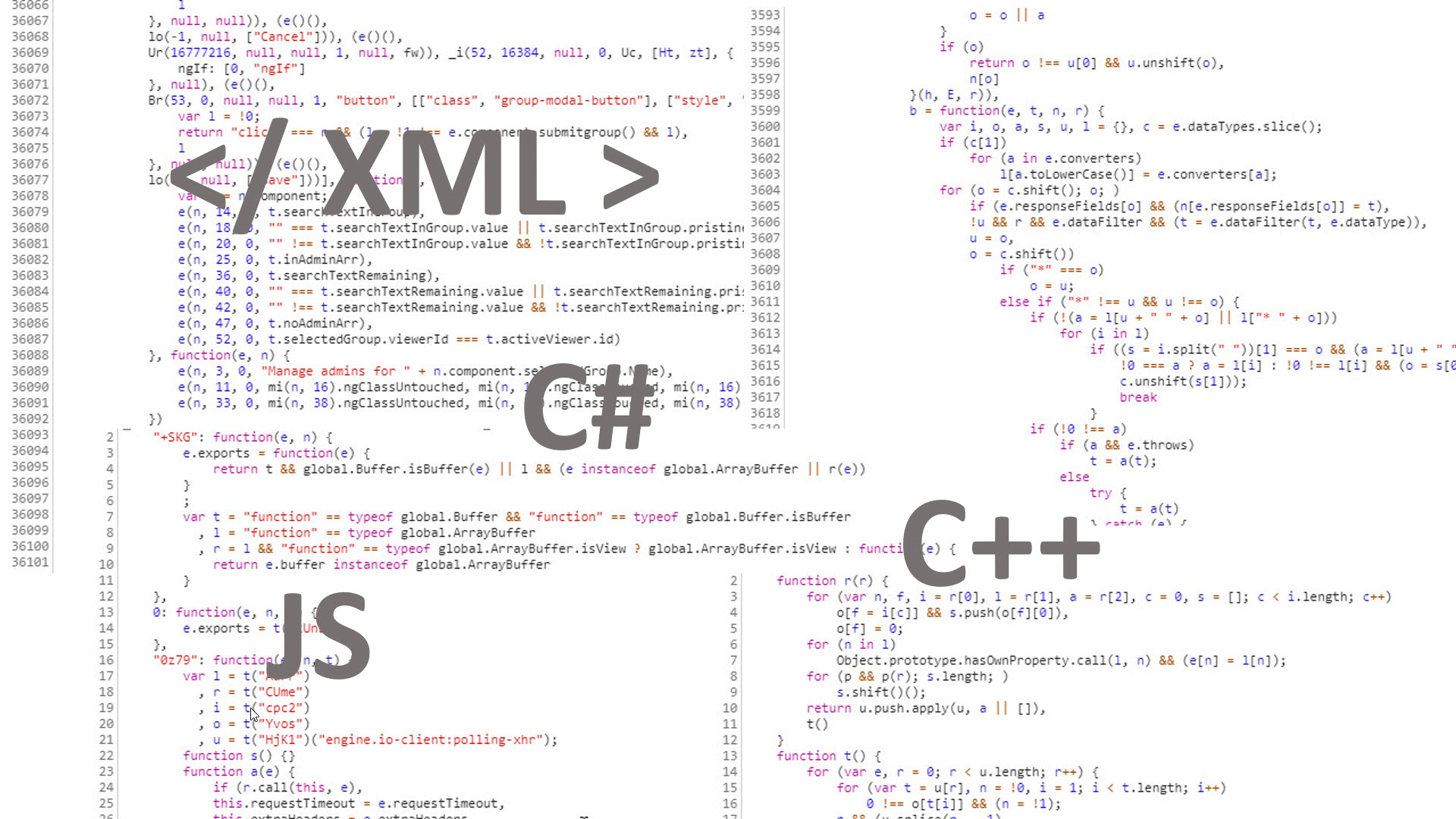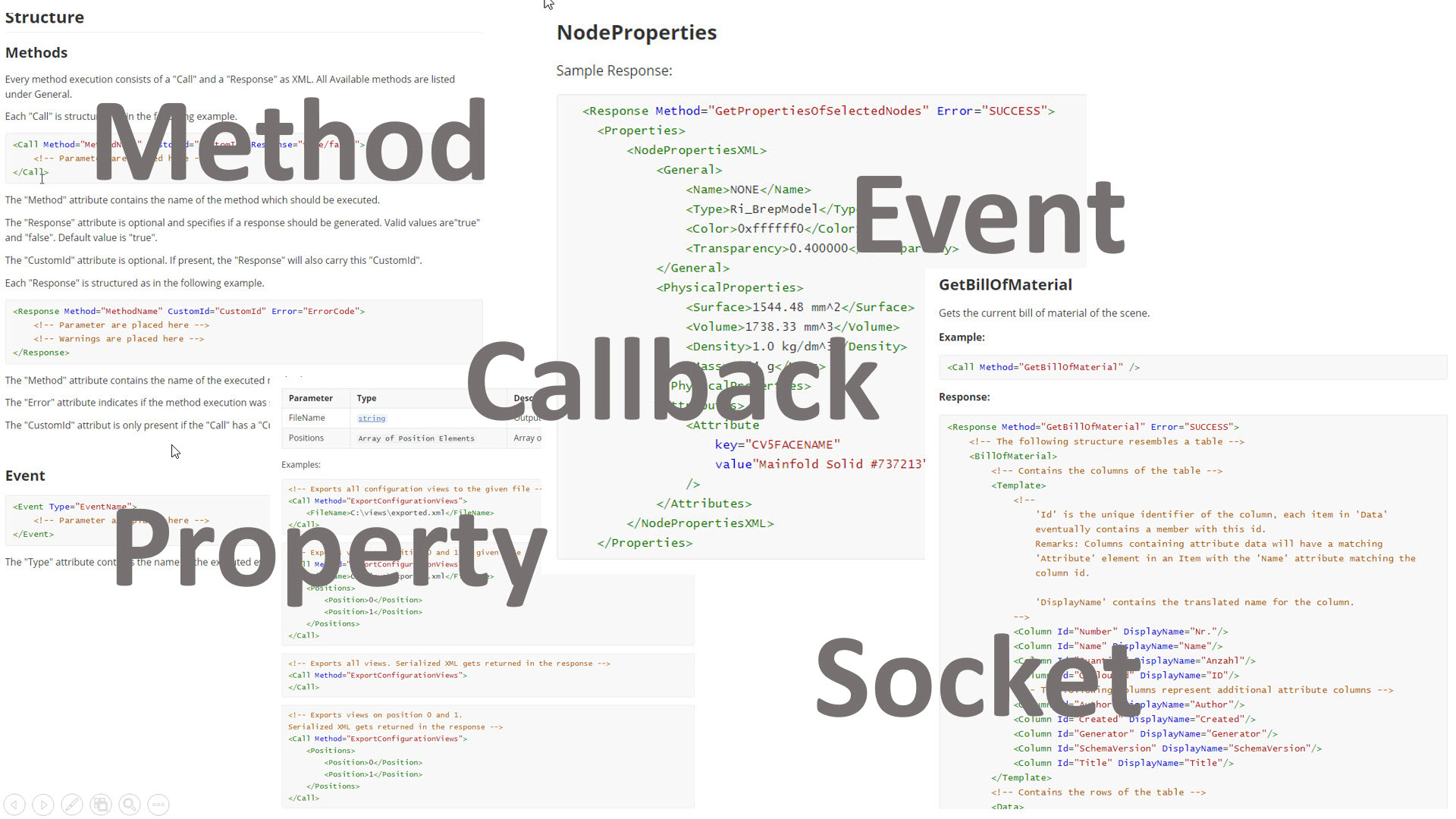
Integration made easy
Use 3DViewStation for visualization in your PLM system, product configurator, after-sales solution (MRO), HMI or any other application
Topics such as digitization and digtal thread are on everyone's lips. These include leading systems that allow processes to be mapped electronically. Software such as PDM or Product Lifecycle Management systems manage CAD data over the product lifecycle (PLM). They may supply a specialized system such as a product configurator with the basic information for defining variants and configurations, as well as CAD data. Once a product has been manufactured and delivered, after-sales (Maintenance Repair Overhaul, MRO) solutions come into play. What they all have in common is that they help users get an overview much faster and more efficiently if they have a powerful viewer. Customers buy faster when they can view the configured product or the spare part selected within an assembly.
All members of the Kisters 3DViewStation product family can be operated as viewer in a stand-alone manner. Companies that use 3DViewStation in an integrated manner provide their users with an additional, visual way to access the information they are looking for more efficiently and to make decisions faster and more reliably. This addition of a 3D CAD graphics component is very useful for us humans who are visually oriented.

Advantages ...
... for users
- Quick visual impression
- One product as 3D CAD Viewer, 2D CAD Viewer, Office Viewer, PDF and Image Viewer
- Extensive interactive functionalities - the right thing for everyone
- Same range of functions also for mobile devices and browsers
- Visualize the same data optionally and without further preparation in desktop, web and VR version
- Viewer for e.g. Aras Innovator, Siemens Digital Industries Teamcenter, Dassault 3DExperience, Contact Cimdatabase, Autodesk, etc.
- Linking CAD data and textual information is made easy
- Information is now only a mouse click away
- Visualization can be used for selection before CAD processing
... for developers
- Rapid implementation of your integration
- only one integration for all users: 3D CAD data, 2D drawing, office document, image
- Few lines of programming code required, as no SDK
- Applications with rich API - more than just viewing
- Bidirectional integration possible
- configure view
- Only minor adjustments necessary when switching between desktop, web / mobile and VR integrations
- Competent consulting team helps with all integration questions
... for decision makers
- Users work much more efficiently and faster
- More reliable decisions
- Many automation possibilities
- Zero Admin: No client installation (for Web application)
- More satisfied users
- Cost control: Even the simplest end devices can be used (for Web applications)
- Cost control: only little effort when switching between desktop, web / mobile and VR
- Cost control: Concurrent licensing models available
Today, several problems may arise when visualizing 3D CAD data within leading systems:
- On one hand, many systems are not equipped to deal with the increasing complexity of mechanical CAD data - which can be as complex as millions of parts and involves a large number of variants and configurations
- On the other hand, an integration should be relatively easy to implement as well as bidirectional – but, this can prove to be quite demanding, since different processes for different user groups should be mapped
- In addition, there is an increasing tendency to use web-based solutions to run on premises or in the cloud, especially for larger numbers of users.
We would be happy to advise you
Sales Germany
+49 2408 9385 517
Sales USA
+1 916 723 1441
The perfect solution for all these scenarios is the 3DViewStation:
This is not a toolbox (toolkit, SDK), rather a ready-made application that can be integrated. Take advantage of our powerful APIs that allow you to create sophisticated integrations in a short time with just a few lines of code. You have a free choice of clients: from desktop to web (HTML5), mobile to VR. All members of the 3DViewStation product family are very fast - ideal for processing even complex data.
Some questions about the integrated 3DViewStation usage:
The first thing to note is that 3DViewStation can be integrated with any PLM system. It is the perfect PLM CAD viewer. Systems into which 3DviewStation has already been integrated include Enovia SmarTeam and 3DExperience platform from Dassault Systemes, TeamCenter and Active Workspace from Siemens Digital Industries, CIM Database from Contact Software, Aras Innovator, ProCAD ProFile, Infor Descrete, Cassini PLM and SAP DVS & CAD-Desktop. The integrations range from classic viewing, redline/markup, change management to CAD data analysis.
First of all, as an advanced PLM CAD viewer, 3DViewStation offers more than 180 functionalities, far more than typical viewers usually offer. We offer functions for navigating and inspecting complex assemblies, measuring, dimensioning and analyzing CAD data, redline and markup for change requests or comparison from within the PLM system. Because 3DViewStation is very fast on the one hand and can handle extremely large amounts of data on the other, visualization can now also be used to define or isolate a subset within a complex assembly in the viewer to be subsequently processed in a CAD session. This avoids a typical limitation of CAD systems, which are often not able to load a complete product.
The 3DViewStation provides the 3D graphics for product configurators, also called CPQ (Cost Price Quote) solution e.g. for DESEC at Deutz, Tacton at Fläkt, and Valtech at DAF. But there are also other configuration management solutions, such as our customer Leonardo with Aras Innovator (PLM) or Kostal with CIM Database (PLM), where 3DViewStation is used as a dynamic 3D viewer. Simple solutions rely on a so-called 150% model, which is more or less reduced by predefined configuration matix, objects are shown or hidden. Far more sophisticated is the completely dynamic visualization in real time, depending on the action of a user. The necessary 3D objects - parts or components - are loaded and placed, unused objects are unloaded. On the one hand, this is done to keep the amount of data within limits, on the other hand, if the number of variants is so high that one cannot or does not want to map all possible combinations in a matrix in advance. Configuration solutions with good 3D graphics can also be found in layouting solutions for plants, such as the LeegooBuilder from EAS-Solutions. Here, plant components can be selected interactively and placed in such a way that they snap into place at specific locations.
Many Service Lifecycle Management (SLMS), After Sales, MRO (Maintenance Repair Overhaul) applications today still do not have 3D graphics, unlike systems such as Kisters LCAM or Cimpa iSLM, which use 3DViewStation. Certainly, the organization and planning of maintenance tasks and resources is a very important part of such a solution. However, in the execution phase, clear instructions with preferably less text and more 2D or 3D graphics are useful for the worker on site. When the viewer, such as 3DViewStation, provides links from 3D parts or components to reports, instructions or into the spare parts system, these are clear advantages that lead to greater user acceptance, productivity and efficiency.
Quality assurance solutions such as Kisters FastQ at DLR, collaboration and project management solutions, also for the construction industry (e.g. EPLASS) and spare parts solutions (e.g. Quanos CatalogCreator), long-term archiving solutions (LTA, LOTAR) for 2D drawings and 3D CAD data (e.g. ImageMaster from T-Systems), but also DMS, CMS, MES and ERP systems.
There are customers who operate the 3DViewStation as a graphical component for CAD data in the human-machine interface (HMI). The 3DViewStation WebViewer is the ideal graphics engine for service applications, which not only alerts the technicians but also shows them immediately in the 3D CAD model where exactly the problem exists in the machine. With the as-maintained data on board the machine, you have everything in the right place to query current status or historical data, to perform maintenance, troubleshoot problems or order spare parts.
For developers we have compiled information here:
Examples of integration scenarios:
- Integrated CAD visualization
- Bidirectional integration
- Performance optimized visualization: 1 second even for complex assemblies is possible
- Visualization of variants and configurations, including metadata
- Hyperlinking (intelligent 3D data): Clicking on geometry triggers an event, e.g. a link to a document, to a 3D model, to a data set etc.
- Highlighting of geometries, controlled by leading application
- Create 3D assemblies via API and transformation matrices directly from the PDM system
- Use of 180+ interactive visualization & analysis functions also within the integration
- 3D-CAD Viewer, 2D-CAD Viewer, Office Viewer, Image / Bitmap Viewer, Connect Universal Viewer
- Extend the 3DViewStation with customized plug-ins to meet specific customer requirements: e.g. to import/overwrite attributes / metadata, read other data formats, interact with CAD or PLM systems, automate repetitive tasks..
- Extension of a system with a 3D viewer for standard formats such as STEP and JT
- Integrate the 3DViewStation as 3D viewer and/or 2D viewer into the surface of your system (in place) or operate it with full surface
- Use 3DViewStation as 3D/2D viewer for fat clients and web clients of any leading system
- Online Viewer, Browser CAD viewer, Desktop CAD viewer, Desktop viewer for drawings and Office
- Fast Viewer for product development, collaboration, project engineers, training, Request for Quotation, work preparation, manufacturing, marketing
- Implement a 3D/2D comparison function from PDM systems
- Extend a PLM or other system with an integrated VR component that can be controlled via API
- Viewer for a product data management studio, e.g. for Catia, Creo, NX, Solidworks, Solid Edge, other MCAD, ECAD or CAM data
- Create thumbnails / thumbnails of 3D models automatically

